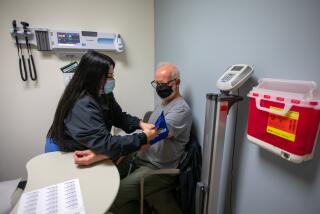Study: Doctors delay communicating end-of-life care issues with terminally ill patients
- Share via
Most doctors don’t talk about end-of-life issues with their cancer patients when those patients are feeling well, a new survey has found. Nor do they talk about them until treatments have been exhausted. Those delays mean patients might not be able to make truly informed choices early in their treatment.
The study, published online Jan. 11 in the journal Cancer, surveyed 4,188 physicians about how they would talk to a hypothetical cancer patient with four to six months to live. A majority of respondents (65%) said they would discuss prognosis, but only a minority said they would discuss do-not-resuscitate status (44%), hospice (26%) or preferred site of death (21%) at that time. Rather, they would wait until symptoms were present or until there were no more treatments to offer.
Current guidelines, from the National Comprehensive Cancer Network, a not-for-profit alliance of 21 of the world’s leading cancer centers, say that such conversations should be initiated whenever a patient has been given less than a year to live, if not at diagnosis.
Doctors gave various reasons for not following the guidelines. Some didn’t want to dash patients’ hopes; some wanted to continue treating patients. In addition, said lead author Dr. Nancy Keating of Harvard Medical School: “There’s at least some evidence to suggest that patients don’t want to hear about these things.”
Here’s a closer look at why end-of-life discussions are important.
If done sensitively and as part of ongoing medical care, discussing whether to resuscitate, when to seek hospice care and where patients want to spend the last days of their lives can actually empower patients, rather than making patients lose hope, say Keating and other palliative care experts. Instead, the talks help patients gain some control over treatment and over the final stage of their lives.
“My own view about this is that the whole approach to dying is really an approach to living,” says Dr. Katherine Kahn, a UCLA physician and co-author of the new study. “The more we can make these discussions about end of life part of a larger set of discussions with patients about how they approach medical care and how they approach life, the better we can honor their medical wishes when it comes time.”
To do this, patients and doctors need to accept the facts, says Dr. Michael Levy, an oncologist at Fox Chase Cancer Center in Philadelphia. He chaired the panel that crafted the cancer network guidelines.
Only 15% of patients with Stage 4 cancer have a viable chance at a cure, he says, and even in those patients, only 50% are cured. “That means that 92.5% of patients with advanced disease will die of their cancer,” Levy says. “So you’ve got to just talk about it.”
Patients may not fully understand the implications of additional chemotherapy or aggressive interventions. Further chemotherapy can limit the number of days in which they feel well enough to enjoy the company of friends and loved ones. And interventions such as cardiopulmonary resuscitation often don’t work as well as people expect. Less than 10% of cancer patients who get CPR recover enough to leave the hospital, according to a 2007 review published in the American Journal of Hospital Palliative Care.
A study published Jan. 10 in the Journal of Clinical Oncology found that patients who watched a six-minute video explaining lifesaving procedures, hospitalized care and palliative care made much different choices than those patients who didn’t watch the video.
Of 23 brain cancer patients who watched the video, 91% chose care designed primarily to keep them comfortable rather than basic hospital care or life-prolonging care. The latter includes CPR and ventilation. Of 27 subjects who heard a description of the different care levels but didn’t watch the video, 22% chose comfort care, 52% chose basic care and 26% of patients chose life-prolonging care.
Research also has shown that informing patients about end-of-life care can reduce medical costs. (See related story.) Moreover, nurses and family members reported more physical distress and worse quality of death in the uninformed patients.
In addition to medical costs, the number of treatments and the amount of suffering go up when patients are not informed about palliative care choices, says Dr. Ira Byock, director of palliative medicine at Dartmouth-Hitchcock Medical Center in Lebanon, N.H. “When I look at the unnecessary costs that accrue at the end of life, the first ones I see are the high human costs of suffering and the toll that that takes on patients’ -- and families’ -- well-being.” He described one woman with advanced cancer who was sedated and intubated in the intensive care unit after a bowel obstruction. “To her family, the worst thing they can imagine is their dear mother dying,” he says. “To those of us who do this work, we know that in fact there are worse things than someone you love dying. The most obvious thing that is worse is having someone you love die badly, to see them die suffering. Often they’re sedated or having their hands physically tied down so they can’t remove [tubes]. Perhaps even worse than even that is realizing at some point that your loved one’s suffering is largely unnecessary.”
In order to have such conversations, doctors first must give up their own notions of what constitutes good care, Levy says. Reflecting on his early years in cancer care, Levy acknowledges: “I honestly found it easier to give end-of-life care to someone else’s patient than my own. Because [after] having entered that contract of ‘I’m going to control your disease, I’m going to get it,’ it really is hard not to feel some sense of failure.”
By reframing the doctor’s job -- or contract, as Levy calls it -- palliative care becomes a useful and necessary part of care. He says doctors’ jobs are to provide care for that patient rather than engage in battle with the cancer.
Keating says many doctors are more comfortable when patients say they want to do everything possible to fight their cancer. Then the doctor can simply move on to the next treatment plan, which might have some effect. “But what does ‘some effect’ mean?” she asks. “It might slow the progression of your tumor temporarily, but it’s not going to cure you. I think that’s where the lack of communication is the most important.”
In fact, the hypothetical patient from Keating’s survey was by definition already eligible for hospice care -- “a significant package of services for patients and families,” Byock says.
Under Medicare, people 65 and older are entitled to hospice care. “In not mentioning that to patients, the clinicians are limiting access to valuable services in a way that does not conform with best practice,” he says.






